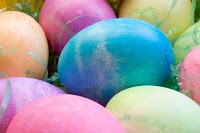Wikipedia also indicates that the egg is widely used as a symbol of the start of new life. Eggs were painted in the spring by the ancient Persians (over 2,500 years ago) for Nowrooz, their New Year celebration, which falls on the Spring equinox. Eggs were traditionally used during the Jewish Passover Seder, during which a hard-boiled egg dipped in salt water symbolizes the festival sacrifice offered at the Temple in Jerusalem. The pre-Christian Saxons had a spring goddess called Ēostre, who feast was held on the Spring Equinox. Her animal was the spring hare (Easter Bunny?), and eggs were used to represent the rebirth of the land in spring time. The English name for the festival of Easter derives from the Germanic word Eostre.
In fact, in Germanic languages, the word for the celebration we know as Easter is derived from Eostre. However, most other European languages use a term derived from the Hebrew "pasch", which means Passover. In French, it is Pâques; in Spanish, it is Pascua; in Dutch, Pasen; in Greek, Russian and the languages of most Eastern Orthodox countries: Pascha.
So now that I've cited wikipedia as my source, please note that I will not guarantee accuracy. It is wikipedia, after all.
Of course, the reason Christians observe Easter is to comemmorate and celebrate the Resurrection of Jesus Christ. But it seems as if Easter Eggs are just an ancient celebration of Spring. And a fun tradition! MOH Joce and I decorate Easter Eggs on Good Friday, which was a lot of fun. We should have taken pictures, but we didn't. So here are some other Easter Eggs!
(Most of these Easter Eggs were taken from wikipedia. They include a mixture of the famous Polish Eggs, Czech Eggs, Canadian/American Eggs, and varying other ways of decorating Easter Eggs.)














1 comment:
How fun are all those eggs! Have a happy Easter!
Post a Comment